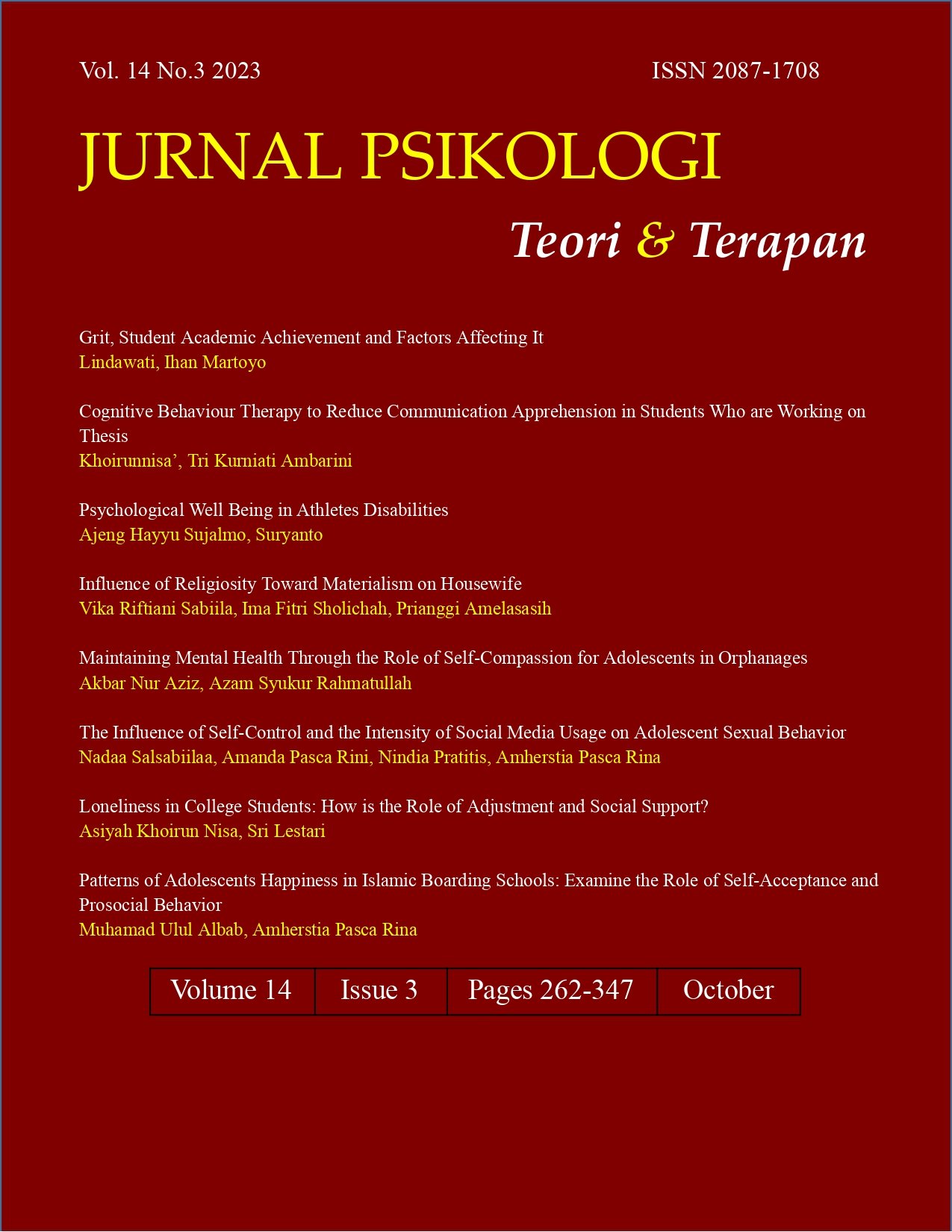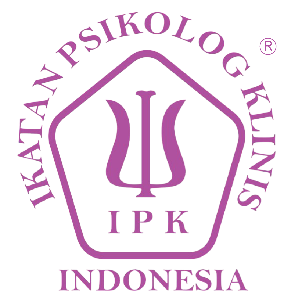Cognitive Behaviour Therapy to Reduce Communication Apprehension in Students Who Are Working on Thesis
DOI:
https://doi.org/10.26740/jptt.v14n03.p270-280Keywords:
CBT, college student , communication anxiety , thesis , kecemasan komunikasi, mahasiswa, skripsiAbstract
The complexity of writing a thesis causes difficulties or obstacles for students, which can result in the emergence of anxiety symptoms. This study aims to determine whether the Cognitive Behaviour Therapy (CBT) approach can reduce the level of communication apprehesion experienced by students who are working on a thesis. Study 1 used a quantitative experimental method with a non-control group design and study 2 used a qualitative method. The participants in this study were 5 students from one of the universities in Surabaya. The results of study 1 show that providing interventions in the form of group counseling with a CBT approach can reduce the level of communication apprehension experienced by students who are working on their thesis. The results of study 2 show that group members can change their cognitive distortions so that they have a more positive thought process. Group members are also able to apply CBT strategies that have been done together to reduce their communication anxiety so that it can increase the effectiveness of communication in preparing the thesis.
ABSTRAK
Kompleksitas penulisan skripsi menimbulkan kesulitan ataupun kendala bagi mahasiswa, yang dapat berakibat munculnya gejala-gejala kecemasan. Penelitian ini bertujuan untuk mengetahui apakah pendekatan Cognitive Behaviour Therapy (CBT) dapat menurunkan tingkat kecemasan komunikasi yang dialami oleh mahasiswa yang sedang mengerjakan skripsi. Studi 1 menggunakan metode kuantitatif eksperimen dengan non control group design dan studi 2 menggunakan metode kualitatif. Partisipan dalam penelitian ini adalah 5 orang mahasiswa dari salah satu universitas di Surabaya. Hasil studi 1 menunjukkan bahwa pemberian intervensi berupa konseling kelompok dengan pendekatan CBT dapat menurunkan tingkat kecemasan komunikasi yang dialami oleh mahasiswa yang sedang mengerjakan skripsi. Hasil studi 2 menunjukkan bahwa anggota kelompok dapat mengubah distorsi kognitifnya sehingga memiliki proses berpikir yang lebih positif. Anggota kelompok pun mampu untuk menerapkan strategi-strategi CBT yang telah dilakukan bersama untuk menurunkan kecemasan komunikasinya sehingga dapat meningkatkan keefektifan komunikasi dalam penyusunan skripsi.
References
Ayres, J., Keereetaweep, T., Chen, P. E., & Edward, P. A. (1998). Communication apprehensionand employment interviews. Communication Education, 47, 1-17.
Baldwin, H. J., Mc Croskey, J. C., & Knutson, T. (1979). Communication apprehension in the pharmacy student. American Journal of Pharmaceutical Education, 43(2), 91-98.
Berger, B. A., & Mc Croskey, J. C. (1982). Reducing communication apprehension in pharmacy student. American Journal of Pharmaceutical Education, 46(2), 132-136.
Cattie, J. E., Buchholz, J. L., & Abramowitz, J. S. (2020). Cognitive therapy and cognitive behavioral therapy. In S. B. Messer, & N. J. Kaslow, Essential Psychotherapies: Teory and Practice (pp. 142-182). New York: Guildford Press.
Corey, G. (2014). Theory & practice of group counseling. United States: Cengage Learning.
Erford, B. T. (2015). 40 Techniques every counselor should know. Boston: Pearson.
Fitriyana, N., & Niko, P. F. (2020). Pengaruh efikasi diri terhadap communication apprehension pada mahasiswa baru tahun pertama Universitas Muhammadiyah Riau. Psibernika, 13(2).
Fitriyana, N., Karmiyati, D., Yuniardi, M. S., & Widiantoro, D. (2020). Hubungan antara self-efficacy dengan kecemasan komunikasi interpersonal pada mahasiswa baru. Personifikasi: Jurnal Ilmu Psikologi, 11(1), 109-124.
Gog, M. (2015). Case study research. International Journal of Sales, Retailing and Marketing, 4(9), 33-41.
Graue, C. (2015). Qualitative data analysis. International Journal of Sales, Retailing and Marketing, 4(9), 5-14.
Hasan, A. (2008). A tool to teach communication skills to pharmacy student. American Journal of Pharmaceutical Education, 72(3), 150-155.
Hepi, N. F., Mira, W., & Rachmawati, A. (2018). Pelatihan efikasi diri komunikasi untuk menurunkan communication apprehension pada mahasiswa baru tahun pertama. Nathiqiyyah - Jurnal Psikologi Islam, Retrieved from https://ojs.diniyah.ac.id/index.php/Nathiqiyyah/article/view/40.
Leahy, R. L., & Rego, S. A. (2012). Cognitive restructuring. In W. O'Donohue, & J. E. Fisher. Cognitive Behavior Therapy: Core Principles for Practice (pp. 133-158). New Jersey: John Wiley & Sons, Inc.
Mansur. (2009). Metode penelitian dan teknik penulisan laporan karya ilmiah. Bandung: Universitas Padjajaran.
Matsuoka, R., & Rahimi, A. (2011). The positive effect of conference participation on reducing L2 communication apprehension. Procedia Computer Science, (3), 898-907.
McCroskey, J. C. (2005). An introduction to rhetorical communication. Englewood Cliffs, NJ: Prentice Hall.
Miles, M. B., & Huberman, A. M. (1994). Qualitative data analysis: an expanded sourcebook, 2nd ed. Thousand Oaks, California: Sage Publication.
Nayeem, N., Khan, S., & Mehta, S. K. (2015). Communication apprehension and its effect on pharmacy student. World journal pharmacy and pharmaceutical science, 4(12), 951-957.
Puspitasari, R. T. (2013). Adversity quotient dengan kecemasan mengerjakan skripsi pada mahasiswa. Jurnal Online Psikologi, 1(1).
Rakhmat. (2012). Psikologi komunikasi. Bandung: PT Remaja Rosdakarya.
Rogers, E. R., & King, S. R. (2012). The Influence of a patient-counseling course on the communication apprehension, outcome expectations, and self-efficacy of first-year pharmacy students. American Journal of Pharmaceutical Education, 76(8), 152-159.
Rust, C., Gentry, W. M., & Ford, H. (2020). Assessment of the effect of communication skills training on communication apprehension in first year pharmacy students - A two-year study. Currents in Pharmacy Teaching and Learning, 12 (2), 142-146.
Schoch, K. (2020). Case study research. In research design and methods: an applied guide for the scholar-practitioner (pp. 245-258). Sage Publication, Inc.
Sidauruk, E. (2016). Hubungan self-regulation dengan communication apprehension mahasiswa universitas pendidikan indonesia. Doctoral dissertation, Universitas Pendidikan Indonesia.
Tellis, W. M. (1997). Application of a case study methodology. The Qualitative Report, 3(3), 1-19.
Thomas, G. (2021). How to do your case study, 3rd ed. London, UK: Sage Publications Ltd.
Twohig, M. P., & Dehlin, J. P. (2012). Skills training. In W. O'Donohue, & J. E. Fisher. Cognitive behavior therapy: Core principles for practice (pp. 37-74). New Jersey: John Wiley & Sons.
Wakhyudin, H., & Putri, A. D. (2020). Analisis kecemasan mahasiswa dalam menyelesaikan skripsi. Wasis: Jurnal Ilmiah Pendidikan, 1 (1), 14-18.
Downloads
Published
How to Cite
Issue
Section
License

This work is licensed under a Creative Commons Attribution-NonCommercial 4.0 International License.
Authors who publish in this journal agree to the following terms:
Copyright in any article is held by the author.
The author grants the journal, publication rights with the work simultaneously licensed under a Creative Commons Attribution License that allows others to share the work with an acknowledgment of the work's authorship and initial publication in this journal.
Authors may enter into separate, additional contractual arrangements for the non-exclusive distribution of the journal's published version of the work (e.g., posting it to an institutional repository or publishing it in a book), with an acknowledgment of its initial publication in this journal.
Authors are permitted and encouraged to post their work online (e.g., in an institutional repository or on their website) prior to and during the submission process, as this can lead to productive exchanges, as well as earlier and greater citation of published work.
 Abstract views: 897
,
Abstract views: 897
, PDF Downloads: 707
PDF Downloads: 707


















